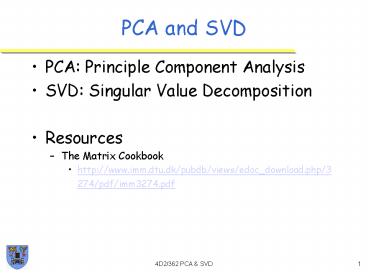PCA and SVD PowerPoint PPT Presentation
1 / 20
Title: PCA and SVD
1
PCA and SVD
- PCA Principle Component Analysis
- SVD Singular Value Decomposition
- Resources
- The Matrix Cookbook
- http//www.imm.dtu.dk/pubdb/views/edoc_download.ph
p/3274/pdf/imm3274.pdf
2
PCA and SVD
- A popular technique in information/data
processing is to transform the data into a
different format. - Examples represented by one set of features are
transformed to another set of features. - Less features
- Less noise
- Typically a linear transformation
3
Principle Component Analysis (PCA)
- Example 2D data projected to 1D PC
- Variability of the data can be described using
only a small number of dimensions - Works well when input features are correlated.
- New dimensions (PCs) are uncorrelated.
4
Linear Discriminant Analysis (LDA)
- PCs are not necessarily good for discrimination
in classification. - Linear Discriminant Analysis (LDA), seeks to find
a linear transformation by maximising the
between-class variance and minimising the
within-class variance. - i.e. discriminating features.
5
Linear Discriminant Analysis
- Projecting a 2D space to 1 PC
PC not discriminating
(from slides by Shaoqun Wu)
6
Linear Discriminant Analysis
LDA discovers a discriminating projection
PCA
This issue will make more sense later.
7
PCA and SVD
- Performing PCA is the equivalent of performing
Singular Value Decomposition (SVD) on the data. - Any nxm matrix X can be rewritten as
- XTSVT
- T is eigenvectors of XXT (nxn)
- S is diag(eig(XXT) (nxm)
- V is eigenvectors of XTX (mxm)
8
Latent Semantic Indexing
- Latent Semantic Indexing is a method for
selecting informative subspaces of feature
spaces. - It was developed for information retrieval to
reveal semantic information from document
co-occurrences. - Terms that did not appear in a document may still
associate with a document. - LSI derives uncorrelated index factors that might
be considered artificial concepts.
9
Latent Semantic Indexing
10
Deciding relevance based on terms...
(Deerwester et al. 1990)
11
LSI Paper example
Index terms in italics
12
term-document Matrix
13
Latent Semantic Indexing
14
T0
15
S0
16
D0
17
SVD with minor terms dropped
TS define coordinates for documents in latent
space
18
Terms Graphed in Two Dimensions
19
Documents and Terms
20
Change in Text Correlation

